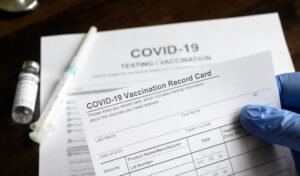
By: Julie K. Hopkins
Background
On November 5, 2021 OSHA published an Emergency Temporary Standard (ETS) requiring employers with 100 or more employees to either adopt mandatory vaccination policies, or implement masking and weekly testing for unvaccinated employees. To recap, here is a brief overview of the ETS:
- The standard applies to employers with 100 or more employees in total, even if the employer has no single worksite where 100 or more employees are present;
- The ETS provides for either adoption of a mandatory vaccination policy, OR a policy requiring unvaccinated employees to wear approved facemasks and undergo weekly COVID-19 testing;
- Covered employers are required to adopt one of the above policies, and provide notice of their policy to their employees on or before December 5, 2021.
- Covered employers must also provide the following government form notices to employees or before December 5, 2021:
- The CDC “Key Things to Know About COVID-19 Vaccines”
- The OSHA Fact Sheet “Workers’ Rights under the COVID-19 Vaccination and Testing ETS”
- The OSHA Facts Sheet “Information for Employees on Penalties for False Statements and Records”
- Covered employers must maintain documentation of their employees’ current vaccination status starting as of December 5, 2021;
- Covered employers must require unvaccinated employees to wear facemasks starting on December 5, 2021;
- Covered employers must report each employee COVID-19 fatality to OSHA within 8 hours of learning about the fatality, and report each employee COVID-19 in-patient hospitalization to OSHA within 24 hours of learning about the in-patient hospitalization, starting on December 5, 2021.
- The employer’s vaccination mandate or alternative weekly testing requirements must take effect by January 4, 2022;
Immediately after the ETS was published in the Federal Register it was challenged in the Fifth Circuit Court of Appeals. And on November 6, 2021, the Fifth Circuit issued a temporary stay to pause OSHA’s implementation of the ETS. Because under the stay OSHA was ordered not to take any further steps to implement or enforce the ETS, the stay had a nation-wide effect, providing relief to all US employers with 100 or more employees, not just those in the Fifth Circuit. In recognition of this, OSHA published the following statement on its website:
On November 12, 2021, the U.S. Court of Appeals for the Fifth Circuit granted a motion to stay OSHA’s COVID-19 Vaccination and Testing Emergency Temporary Standard, published on November 5, 2021 (86 Fed. Reg. 61402) (“ETS”). The court ordered that OSHA “take no steps to implement or enforce” the ETS “until further court order.” While OSHA remains confident in its authority to protect workers in emergencies, OSHA has suspended activities related to the implementation and enforcement of the ETS pending future developments in the litigation. (https://www.osha.gov/coronavirus/ets2)
The Case Moves to the Sixth Circuit
The Fifth Circuit is not the only jurisdiction where challenges were filed. In the first few days after the ETS was published, legal challenges were filed with the US Courts of Appeals for all 12 circuits.
As a result on November 16, 2021 OSHA filed a formal notice of these multicircuit petitions with the US Judicial Panel on Multidistrict Litigation, and the panel immediately consolidated the cases into a single matter, and held a lottery to determine which of the circuits would hear the consolidated case. The Sixth Circuit was selected in that lottery. A copy of the consolidation order can be viewed at: https://www.jpml.uscourts.gov/sites/jpml/files/MCP-165-Consolidation_Order-11-16-2021.pdf
What this Means for the Stay
If the case had remained with the Fifth Circuit, then the stay was almost certain to remain in place while the underling case was pending. Now that it has been transferred to the Sixth Circuit, OSHA has the opportunity to ask the Sixth Circuit to revisit and lift the stay put in place by the Fifth Circuit. We do not yet know if OSHA will make such a request. But OSHA’s statement that it will suspend its activities related to the ETS pending future developments in the litigation does not foreclose a swift request to lift the stay.
Arguably a failure by the agency to challenge the stay as quickly as possible at the Sixth Circuit could weaken its underlying case. In the preamble to the ETS, the administration takes the position that it is required to issue this ETS under the OSH Act, because immediate action is necessary to protect employees from the grave workplace danger posed by COVID-19. Because the idea that “speed is of the essence” is central to OSHA’s justification for issuing the ETS, it is unlikely that the administration will not try every available option to challenge the stay.
What Employers Should Do Now
Although the Sixth Circuit is viewed as a fairly conservative jurisdiction, there’s no guarantee that it will affirm the Fifth Circuit’s stay. For this reason we are advising covered employers not to take a purely wait and see approach to the ETS. The compliance burden this ETS places on employers is substantial, and it would be a challenge to implement even within the 30 and 60 day windows originally provided. As the penalties for noncompliance can range from $14,000 to over $100,000 per violation, employers need to be ready with a plan they can execute quickly if the ETS is reinstated.
Here are some things to consider when developing your plan:
- Ensure you have a basic understanding of the requirements of the ETS, and how it might impact you unique workforce;
- Think through whether you would choose to adopt an employee vaccination mandate, or whether you would allow employees to choose whether to get vaccinated, but require unvaccinated employees to comply with masking and weekly testing requirements;
- Identify who on your staff would manage the process of documenting your employees’ vaccination status, and how those records will maintained and updated, when necessary;
- Identify who would manage the process of reviewing requests for accommodation. You are likely receive requests for exceptions on medical and religious grounds if you adopt a mandatory vaccination policy, alternatively you may receive requests for exemptions from masking requirements on medical grounds if you adopt a masking/testing policy;
- If you allow employees to choose the masking/testing option, will your employees have reliable access to testing? The ETS will not recognize tests that are both self-administered and self-read, unless the results are also observed by the employer or an authorized telehealth proctor.
- The ETS provides that employees bear all costs associated with testing, and also that employers do not need to pay employees for time they spent obtaining a test, unless pay is required by a collective bargaining agreement or some other law. So if your policy includes a testing option, either instead of voluntary vaccination, or as an accommodation to your employees who cannot be vaccinated for medical or religious reasons, make sure that your union contracts don’t require you to compensate hourly employees for testing time, or that your testing practices don’t trigger a right to receive pay under wage and hour laws. For example, if you require an employee to submit to on-site testing, and the testing is occurring during his or her regular work hours, as opposed to outside of normal work hours, you will likely be required to pay the employee for their testing time.
- And of course, if you have employees who perform work at third-party worksites, find out what those companies are requiring of their own employees, and whether they intend to require the same of the personnel you send on to their sites as well.
We recognize this is a lot to consider, with many moving parts. If you have any questions, please consult with your labor and employment counsel. And as new developments in this case occur, we will monitor and update this information.
Julie K. Hopkins is an experienced labor and employment advisor and problem solver. She works with diverse clients across a variety of industries to consistently provide the strategic guidance and support that enables organizations to more effectively and efficiently advance their goals while ensuring that their responsibilities to key internal and external stakeholders are met. She can be contacted at jkhopkins@strausstroy.com or 513-629-9459.


